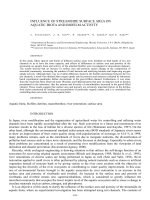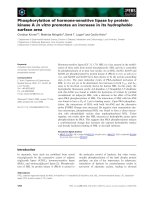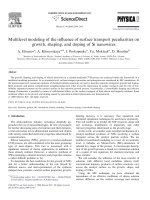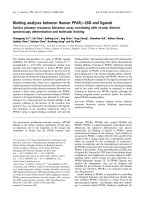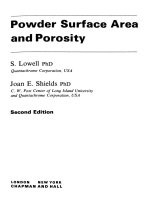- Trang chủ >>
- Khoa Học Tự Nhiên >>
- Vật lý
High specific surface area porous sic ceramics coated with reticulated amorphous sic nanowires
Bạn đang xem bản rút gọn của tài liệu. Xem và tải ngay bản đầy đủ của tài liệu tại đây (419.96 KB, 5 trang )
Physica E 40 (2008) 2540–2544
High specific surface area porous SiC ceramics coated
with reticulated amorphous SiC nanowires
Limin Shi
Ã
, Hongsheng Zhao, Yinghui Yan, Ziqiang Li, Chunhe Tang
Institute of Nuclear and New Energy Technology, Tsinghua University, Beijing 100084, China
Available online 18 October 2007
Abstract
High specific surface area porous SiC ceramics, coated completely with reticulated amorphous SiC nanowires, have been fabricated
with commercially available phenolic resin and silicon powders using a novel method. The results indicate that the specific surface area
and porosity of the as-synthesized materials can be up to 112 m
2
g
À1
and 81%, respectively. The coated amorphous SiC nanowires have
uniform structure and smooth surfaces. The electron emission turn-on field and threshold field are about 2.9 and 6.7 V mm
À1
,
respectively. This kind of materials may simultaneously possess the unique properties of porous materials, SiC, and nanowires. And they
may have promising applications in a wide variety of areas.
r 2007 Elsevier B.V. All rights reserved.
PACS: 61.46.Àw; 81.05.Je
Keywords: Porous; SiC; Nanowires; Ceramics
1. Introduction
Due to their excellent performances, such as low density,
high permeability, and high specific surface areas, porous
materials have found numerous applications, including
filters, catalyst supports, sensors, separations, and tissue
engineering [1,2]. SiC is a typical transition metal carbide
with excellent physical, chemical, mechanical, and electro-
nic properties, which make it extensively used in many
fields such as metallurgy, refractory, and environment
protection [3,4]. During the past two decades, one-
dimensional nanomaterials (nanotubes, nanowires, nanor-
ods, and nanofibers) have attracted considerable attention
because of their unique physico-chemical properties and
wide variety of potential applications [5,6]. It has been
evidenced that the porous SiC ceramics combine the
properties of porous materials with those of SiC. This is
the same with SiC nanowires. In order to meet the stringent
requirements of some applications, various methods have
been developed for fabricating porous SiC ceramics [7,8]
and SiC nanowires [9,10]. Similarly, the preparation of
high specific surface area porous SiC ceramics coated
entirely by reticulated SiC nanowires may make it possible
to obtain a kind of functional and structural material,
which perhaps can simultaneously possess the excellent
properties of porous materials, SiC, and 1D nanomaterials.
Unfortunately, few reports on the fabrication of this
unique material are available until now. Here, we propose
a novel method to synthesize high specific surface area
porous SiC ceramics, which are coated entirely with
reticulated SiC nanowires. Encouraged by the success in
preparing SiC nanowires [11], Al was used as catalyst in the
present experiments. The specific surface area of the porous
SiC ceramics produced in our process can be up to
112 m
2
g
À1
. The porosity is greater than 80%. The electron
emission turn-on field is 2.9 V mm
À1
and the electron
emission threshold field is a s low as 6.7 V mm
À1
. The
reticulated SiC nanowires, which are coated on the external
surface of the as-synthesized porous SiC ceramics, are
amorphous. At the same time, the SiC nanowires have
uniform structure and smoot h surface.
ARTICLE IN PRESS
www.elsevier.com/locate/physe
1386-9477/$ - see front matter r 2007 Elsevier B.V. All rights reserved.
doi:10.1016/j.physe.2007.10.034
Ã
Corresponding author. Tel.: +86 10 89796095; fax: +86 10 69771464.
E-mail address: (L. Shi).
2. Experimental
Commercially available phenolic resin (barium phenolic
resin; Beijing Fiberglass-Reinforced Plastics Research
and Design Institute, Beijing, China) and silicon powder
(average particle size of 9.4 mm; Beijing Da Di Zelin-Silicon
Limited Company, Beijing, China) were used as carbon
source and silicon source, respectively. Analytical ethanol
was used as solvent and de-ionized water as precipitator.
Aluminum powders were used as catalyst. The fabrication
of porous SiC ceramics constructed by SiC nanowires
consisted of the following steps: (1) Preparation of
precursor powders based on coat-mix proces s [12–14]: After
being properly weighed, 10 g phenolic resin was first
dissolved into 20 g ethanol to form the binder solution,
which was stirred vigorously at 45 1C for 1 h. Ten grams of
silicon powders were subsequently introduced into the
binder solution. After being homogeneously mixed at 45 1C
for another 1 h, the obtained slurry was injected into de-
ionized water. Then, the aqueous solution was stirred at
45 1C for about 2 h. This step was followed by decanting,
filtering and drying. At last, the precursor powders,
core–shell silicon-phenolic resin powders, could be ob-
tained. (2) Molding: The obtained precursor powder s were
pressed into the cylindrical green compacts with a diameter
of 10 mm using a stainless steel mould. The temperature,
pressure and soaking time were maintained at 80 1C,
0.1 MPa and 1 h, respectively. (3) Carbonizing: This step
was performed by heating the green bodies in a program-
mable quartz tube furnace in a flowing Ar atmosphere. For
the sake of not destroying the samples, they were heated
from room ambient temperature to 800 1C with a heating
rate of 0.5 1C min
À1
. The holding time is 2 h at 800 1C. (4)
Sintering: The resul ting carbonized compacts and Al
powders, which were held in a graphite crucible with a
graphite lid, were sintered in a graphite furnace in Ar
atmosphere. Here, the graphite crucible covered by a
graphite lid was used to provide a relatively closed
environment for the synthesis of porous SiC ceramics
coated entirely by SiC nanowires. The heat treatment
started at ambient temperature and stopped at 1500 1C
with a he ating rate of 5 1C min
À1
, then cooled in the
furnace to room ambient temperature. The pressure of Ar
and soaking time were 0.15 MPa and 2 h, respectively.
X-ray diffraction (XRD) pattern of the prepared porous
SiC ceramics was recorded at room temperatur e on a Japan
D/max-IIIA X-ray diffractometer using standard Cu Ka
radiation. Renishaw RM1000 Raman microscope was used
to further investigate the structure of the as-synthesized
products. A Hitachi S-3000N scanning electron microscope
(SEM), operated at an accelerating voltage of 10 kV, was
employed to characterize the morphology of the porous
ceramics. Further structure cha racterization and fast four-
ier transform (FFT) of the SiC nanowires, which coated
with the external surface off fabricated porous SiC
ceramics, were investigated on a Tecnai TF20 high-
resolution transmission electron microscope (HRTEM)
operated at 200 kV. Energy dispersive X-ray spectroscopy
(EDX; attached to the Technai TF20) was employed for
identifying the elemental composition of the SiC nano-
wires. The specific surface area, median pore diameter
(volume), median pore diameter (area), average pore
diameter (4 V A
À1
), bulk density, apparent density, and
porosity of the fabricated porous SiC ceramics were
determined by mercury intrusion porosimetry (AutoPore
IV 9510, Micromeritics, USA). The field emission proper-
ties were measured in a vacuum chamber at room
temperature.
3. Results and discussion
The color of the carbonized compacts is black. However,
it can be seen directly that after heating at 1500 1C for 2 h
with Ar pressure of 0.15 MPa, the color of the samples has
turned into light green. This implies that a complete
conversion of silicon and phenolic resin-derived carbon
into SiC has been achieved at such an experimental
condition. The light green color of the resulted products
also indicates that the as-synthesized porous SiC ceramics
possess a relatively higher purity.
Fig. 1(a) and (b) shows the XRD patterns of the external
and internal surfaces of the porous ceramics fabricated at
1500 1C for 2 h with Ar pressure of 0.15 MPa using our
process, respectively. It can be found from Fig. 1(a) that no
obvious diffraction peaks of SiC crystals existed in the
XRD pattern of the external surface of the as-synthes ized
materials. This indicates that the external surface of
the resulting ceramics is amorphous state. As shown in
Fig. 1(b), the five sharp characteristic peaks correspond to
the (1 1 1), (2 0 0), (2 2 0), (3 1 1) and (2 2 2) planes of b-SiC
ARTICLE IN PRESS
Fig. 1. XRD patterns ((a) external and (b) internal) of high specific
surface area porous SiC ceramics coated with reticulated SiC nanowires
fabricated at 1500 1C for 2 h with Ar pressure of 0.15 MPa using our
proposed process. The amorphous nature of the external of the as-
synthesized SiC materials is revealed by the XRD patterns.
L. Shi et al. / Physica E 40 (2008) 2540–2544 2541
phase according to the standard JCPDS cards (29-1129).
Combined with the above XRD analyses, it can be
concluded that the as-synthesized materials are SiC
ceramics coated with amorphous layers.
The SEM images shown in Fig. 2(a) and (b) are
the typical morphologies of the external surface and
fracture surface of the resulted porous SiC ceramics
coated with reticulated SiC nanowires, respectively .
Fig. 2(a) clearly reveals that the external surface of the
fabricated ceramics are constructed completely by reticu-
lated SiC nanowires with uniform diameter distribution
in the range of 30–80 nm, and lengths over several tens
of micrometers. It can also be found from Fig. 2(b) that
the fabricated ceramics have large amounts of irregular
pores.
The further morphology characterization of SiC nano-
wires, which coated on the surface of the as-synthesized
porous SiC ceramics, can be seen clearly by HRTEM
imaging shown in Fig. 3(a). It indicates that the SiC
nanowires have uniform structure and smooth surface. The
chemical composition of the corresponding SiC nanowire
presented in Fig. 3(a) is characterized by EDX spectro-
scopy, as shown is Fig. 3(b). The EDX peaks at 0.26, 0.52,
1.51, 1.73, 0.94, 8.02, and 8.92 keV correspond to the Ka
lines of carbon, oxygen, silicon, aluminum, and the La,Ka,
and K b lines of copper, respectively. The peaks of copper
are originated from the copper grid, which is used to
prepare the TEM sample. The oxygen is probably formed
during the TEM sample preparation. This reveals that the
nanowires are SiC nanowires with a small amount of
ARTICLE IN PRESS
Fig. 2. The representative SEM images ((a) external surface and (b) fracture surface) of the as-synthesized porous SiC ceramics. It can be found that the
fabricated SiC ceramics with large amounts of pores are coated completely with reticulated nanowires with uniform structure.
Fig. 3. (a) Representative TEM images, (b) EDX spectra of SiC nanowires, and (c) HRTEM lattice image of the reticulated SiC nanowires which are
coated on the external surfaces of the porous SiC ceramics prepared using our process. It can be evidenced that the SiC nanowire with a uniform structure
is amorphous, which is further confirmed by the FFT shown in (d).
L. Shi et al. / Physica E 40 (2008) 2540–25442542
aluminum. The corresponding HRTEM lattice image and
FFT shown in Fig. 3(c) and (d) indicate that the SiC
nanowires are amorphous. Thi s is in accordance with the
XRD analysis mentioned above.
Table 1 lists the data for the obtained high specific
surface area porous SiC ceramics co ated completely by
reticulated SiC nanowires measur ed by mercury intrusion
porosimetry. It can be found that the median pore diameter
(volume) and average pore size are 1.6 mm and 25 nm,
respectively. The bulk density is 0.61 g cm
À3
and the
apparent (skeletal) density is 3.19 g cm
À3
. The open
porosity can be up to 81%. Moreover, it is surprising to
find that the specific surface area of the porous materials
prepared by our process is greater than 100 m
2
g
À1
. These
unique properties may make this novel material an
attractive candidate for many potential applications such
as catalysis supports.
Fig. 4 shows the typical plot of emission current density
versus electric field (J–E) for the obtained high specific
surface area porous SiC ceramics coated entirely by
reticulated SiC nanowires. The electron emission is
observed at an electric field of about 2.8 V mm
À1
. The
electron emission turn-on field (E
to
) and threshold field
(E
thr
), defined as the macroscopic fields required to
produce a current density of 10 mAcm
À2
and 10 mA cm
À2
,
are about 2.9 and 6.7 V mm
À1
, respectively. The low E
thr
value indicates that this material produced by our method
may have promising applications in flat panel displays. By
plotting ln(J Á E
À2
) versus E
À1
, a Fowler–Nordheim (F–N)
curve can easily be obtained (inset in Fig. 4). The linearity
of the curve shows that the obtained materials possess a
conventional field emission mechanism.
4. Conclusions
In summary, we have demonstrated a process for the
fabrication of high specific surface area porous SiC
ceramics, which are coated completely with reticulated
amorphous SiC nanowires. Commerci ally available phe-
nolic resin an d silicon powders are employed as carbon
source and silicon source, respectively. The reticulated SiC
nanowires coated on the external surface of the as-
synthesized materials are amorphous phase. Meanwhile,
these SiC nanowires have uniform structure and smooth
surface. The as-synthesized porous SiC ceramics, coated
completely with reticulated amorphous SiC nanowires,
possess high specific surface areas and porosity. The
specific surface area and porosity can be up to 112 m
2
g
À1
and 81%, respectively. The field emission properties of the
obtained high specific surface area porous SiC ceramics
coated by reticulated SiC nanowires are measured. The E
to
and E
thr
are about 2.9 and 6.7 V mm
À1
, respectively. Thus,
we can envisage that the prepared materials may find
interesting applications in filters, catalyst supports, and
electronic devices. Given the simplicity of the procedures
and the unique properties of the as-synthesized materials,
the method described here should attract a great deal of
attention. Other high specific surface area porous carbide
ceramics coated with carbide nanowires may also be
fabricated by this method.
Acknowledgment
This work is supported by Key Faculty Support
Program of Tsinghua University.
References
[1] R.A. Caruso, J.H. Schattka, Adv. Mater. 12 (2005) 1921.
[2] Y.J. Wang, F. Caruso, Adv. Funct. Mater. 14 (2004) 1012.
[3] T. Ishikawa, Y. Kohtoku, K. Kumagawa, T. Yamamura,
T. Nagasawa, Nature 391 (1998) 773.
[4] D. Nakamura, I. Gunjishima, S. Yamaguchi, T. Ito, A. Okamoto,
H. Kondo, S. Onda, K. Takatori, Nature 430 (2004) 1009.
ARTICLE IN PRESS
Table 1
The major properties of the porous SiC ceramics coated entirely by
reticulated SiC nanowires fabricated at 1500 1C for 2 h with Ar pressure of
0.15 MPa using our proposed process
Property Value
Specific surface area (m
2
g
À1
) 112
Median pore diameter (volume) (mm) 1.6
Median pore diameter (area) (nm) 6
Average pore diameter (4 V A
À1
) (nm) 25
Bulk density (g cm
À3
) 0.61
Apparent (skeletal) density (g cm
À3
) 3.19
Porosity (%) 81
It is surprising to find that the specific surface area of the resulting porous
SiC ceramics is greater than 100 m
2
g
À1
, which may help this novel
material find many applications.
Fig. 4. The typical emission J–E plot from the obtained high specific
surface area porous SiC ceramics coated with reticulated SiC nanowires.
The E
to
and E
thr
are about 2.9 and 6.7 V mm
À1
, respectively. Inset: F–N
plot. The linearity of the curve implies that the emission of the high
specific surface area porous SiC ceramics coated with reticulated SiC
nanowires agrees with the properties expected for field emission.
L. Shi et al. / Physica E 40 (2008) 2540–2544 2543
[5] M. Law, L.E. Greene, J.C. Johnson, R. Saykally, P.D. Yang, Nat.
Mater. 4 (2005) 455.
[6] S. Iijima, Nature 354 (1991) 56.
[7] K. Sonnenburg, P. Adelhelm, M. Antonietti, B. Smarsly, R. No
¨
ske,
P. Strauch, Phys. Chem. Chem. Phys. 8 (2006) 3561.
[8] Y. Shin, C.M. Wang, G.J. Exarchos, Adv. Mater. 17 (2005) 73.
[9] Z.W. Pan, H.L. Lai, F.C.K. Au, X.F. Duan, W.Y. Zhou, W.S. Shi,
N. Wang, C.S. Lee, N.B. Wong, S.T. Lee, S.S. Xie, Adv. Mater. 12
(2000) 1186.
[10] H. Ye, N. Titchenal, Y. Gogotsi, F. Ko, Adv. Mater. 17 (2005)
1531.
[11] S.Z. Deng, Z.S. Wu, J. Zhou, N.S. Xu, J. Chen, J. Chen, Chem. Phys.
Lett. 356 (2002) 511.
[12] D. Simwonis, H. Thu
¨
len, F.J. Dias, A. Naoumidis, D. Sto
¨
ver,
J. Mater. Process Technol. 92 (1999) 107.
[13] H. Luhleich, J. Dias, H. Nickel, Carbon 35 (1997) 95.
[14] L. Shi, H. Zhao, Y. Yan, Z. Li, C. Tang, Powder Technol. 169 (2006)
71.
ARTICLE IN PRESS
L. Shi et al. / Physica E 40 (2008) 2540–25442544
